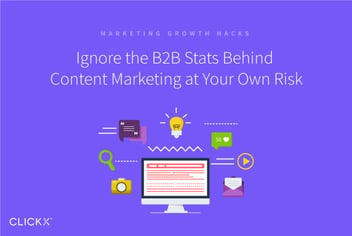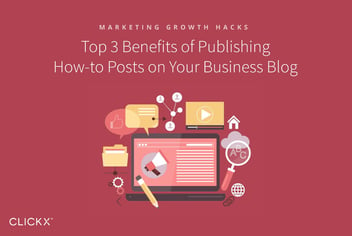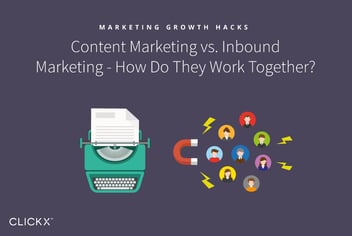Six Things Every B2B Content Marketing Strategy Needs
As of this year, nearly 50 percent of all companies have content marketing strategies. More than three out of four CMOs think that custom content is the future of marketing. No matter what industry you’re in, it’s time to face the music: content marketing is here to stay, and unless you can create and stick to a consistent strategy, you’re going to get left behind.
Don’t know how to develop a B2B content marketing strategy? That’s okay—every campaign has to start somewhere. Before you start producing content, though, you need to understand the six key aspects of every successful content marketing strategy. Without all of these elements, your strategy is incomplete, and you risk not getting the results that you have in mind.
As you start developing your content marketing plan, consider the six elements critical to a successful campaign:
1. Knowing Your Audience
Whether your target audience is broad or narrow, you need to focus your content. Instead of trying to create content that speaks to your entire target audience all at once, focus on one type of client at a time. Are you writing content for international businesses, or small, local ones? Are you writing for somebody who knows what services they need, or somebody who needs to be educated on their options?
To figure out a sensible starting point, look at one of your company’s best customers, and pretend that you’re writing just for them. What sort of information are they looking for now? What were they looking for when they first came to your company? This brings us to the next key element of your B2B content marketing strategy.
2. Developing a Buyer Persona
Your customers and the people in your target audience don’t exist in a vacuum. They have wants, needs, and priorities, and you need to take the time to understand them before you start writing content. Otherwise, you could spend all your time answering questions that nobody is asking.
A buyer persona is like a personality type—an imaginary person or business that could be interested in what you have to offer. Using your existing customers as a starting point, ask yourself questions about a buyer persona, such as:
- What are their priorities? Their pain points?
- What is their role in their own company?
- How long do they spend on research before buying?
- What questions are they likely to ask you?
Once you have a few different buyer personas fully fleshed out, you’ll have a clearer idea of who you’re writing for, what topics your content marketing should address, and how you should address them.
3. Creating a Road Map for Your Audience
It would be nice if every visitor to your website was ready to buy right away, but that just isn’t the case—especially in B2B industries. That’s what your content marketing strategy is for. The content you create and the way that you provide it can guide your leads through the sales funnel, hitting all the right conversion points along the way.
Because your leads don’t make the leap from first contact to final purchase in a single bound, you need to guide them there with smaller conversion goals. Your first goal, for example, may be enticing a visitor to give you their email address in exchange for an incentive, putting them in your lead database so that you can nurture them over time. A goal toward the bottom of the sales funnel, on the other hand, may be convincing your lead to download a free trial, or to sign up for a free consultation.
Dividing up the sales funnel into smaller goals this way makes the process more manageable, both for you and for your leads.
4. Keeping in Contact with Your Leads
Content marketing isn’t a passive strategy—it’s a hands-on one, and that includes reaching out to your leads. Don’t trust that your leads will guide themselves through the sales funnel, because if you do, they could slip through the cracks. Instead, map out the points at which you’ll reach out to them and make contact.
This doesn’t mean that you need to contact every lead personally—by setting up an automated marketing system, you can ensure that every lead is contacted at the appropriate time. For example, you may set up a system of marketing emails that automatically sends a new message to your leads at predetermined intervals. By maintaining consistent contact like this with the people who are interested in your company, you can stop leads from slipping away unnoticed and turn more of them into customers.
5. Putting It All Together
By this point in the planning stage, you understand your buyer personas, the different conversion goals in your sales process, how and when you want to contact your leads, and what types of content you’re going to produce. The next big step is to figure out how all of those things come together.
For example, choose a buyer persona and ask yourself what might bring them to your site for the first time. What information are they looking for? What kind of timeline are they working with? What type of content would appeal to them at this specific point, and how do you guide them toward that content?
Questions like these help you align the different aspects of your content marketing strategy, so that all of its moving parts work together to provide your leads with the information they want, when they want it.
6. Producing Enough Content
With your plan in place, you’re left with one of the most difficult tasks: actually producing the content that you need. For a B2B content marketing strategy to be effective, it has to be consistent, so you can’t take breaks or skip tasks just because you’re short on time.
What you can do, however, is create content strategically, so that you can repurpose it over time and make things easier for yourself. For example, the different pages of a premium download can be turned into slides for a SlideShare, while the same statistics that you use in a blog post can be used to create an infographic.
By repurposing content this way, you can make it easier not only to maintain consistent messaging across different channels, but also to keep up with a rigid content production schedule.
Getting Started
Now that you know the key components of a B2B content marketing strategy, you can get started developing one of your very own. When you follow these tips and adhere to a consistent schedule, you make it significantly easier to find, engage with and convert the audience your business needs.




